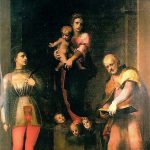The Virgin with Saints Hippolytus and Cassian, dating to the second decade of the 16th century, was originally located at the high altar of the Propositura of Saints Hippolytus and Cassian. In the fresco, the Madonna with the Child in her arms is positioned centrally but elevated, with the two saints placed at her sides. The Virgin wears a red robe, a green mantle, and a violet veil. Near her feet are the pastoral staff and the mitre, while in her arms, the Child—completely naked with curly hair—extends his little hand toward Saint Hippolytus, depicted in military garb with a sword in his hand. On the opposite side stands Saint Cassian, an elderly, thin, and penitent figure, wearing a long violet tunic and a yellow and green cloak edged in red, fastened with a large golden fibula. The saint’s eyes are cast downward, and with his hands, he holds an open book.
A semicircular arch divides the front part from the niche, in which is located the group of the Virgin and Child. The painting is first documented in the pastoral visit of May 24, 1583, during which the Bishop of Sarsina ordered an urgent restoration. In the first half of the 19th century, the Provost Luciani described the work as follows: “[…] A panel of excellent old painting (but in poor condition) representing in the center the figure of the Most Holy Virgin with the Child Jesus in her arms, and on either side the titular saints Hippolytus and Cassian, with a gilded wooden frame, except for the lower side, where it was noted that no gilding had ever been applied […].” The frame was removed before the 20th century, as a photograph from the time shows the panel already without it. In the pastoral visit of June 15, 1872, it was reported that “[…] this painting was drawn by Andrea del Sarto, or at least belongs to his school […].”
The work, characterized by soft chromatic gradations, has been attributed to Domenico Ubaldini, known as Il Puligo (1492–1527), a pupil of Andrea del Sarto (1486–1530). “Domenico di Bartolomeo Puligo,” recorded in the old Libro de’ Pittori di Firenze of 1525, entered the workshop of Ridolfo del Ghirlandaio (1483–1561) at a young age, but his early works were also influenced by the style of Fra’ Bartolomeo (1472/75–1517). The Laterine painting, recognized as a mature work by the artist, shows strong similarities, especially with The Madonna of the Harpies by Andrea del Sarto. The painting was removed from its original location after the earthquake of 1919 and was placed at the back of the right nave.
Manola Rosadini




